Best & Worst of the Aughts
It's been a hell of a decade and the aughts have come to a close. We asked people to chime in about what they loved and hated about the last ten years, including, Karen Wilkin, Johanna Fassl, Ruba Katrib, Gary Panter, William Powhida, Barry Hoggard & James Wagner, Lyra Kilston, and Will Heath.
We’ve been thinking about the best and the worst of the aughts amongst ourselves and wanted to find out what some others thought. The question we asked was:
What are your picks for the best & worst art work, artist, event, cultural phenomenon or object of the last ten years?
Each of those who answered this HUGE and intimidating question did so in their own way, offering us their perspective on the oddly named decade.
Karen Wilkin, critic/curator, New York
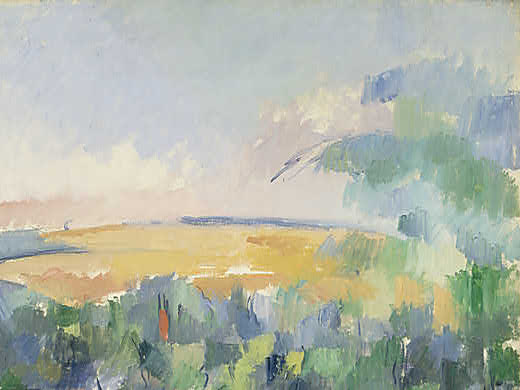
BEST SHOW
Choosing the best show of the past decade is impossible because there have been many really well-conceived, illuminating, but very different exhibits that assembled outstanding works and taught us a lot. How can I choose between, for example, the great Chardin retrospective at the Metropolitan Museum in 2000 and Cézanne in Provence, at the National Gallery, Washington, in 2006, which made pictures we thought we knew look unexpected. There was the beautifully chosen Anthony Caro retrospective at the Tate in 2005, the tightly focused Manet and the Execution of Maximilian at MoMA in 2006-2007, and also at MoMA, the impeccable Georges Seurat: The Drawings and the equally impeccable Martin Puryear retrospective, which overlapped in 2007, the revelatory Jan Lievens retrospective at the National Gallery in 2008, and the glorious Late Titian and the Sensuousness of Painting at the Vienna Kunsthistorisches Museum in 2008. And that’s not to mention this year’s contenders, the dazzling Titian, Tintoretto, Veronese: Rivals in Renaissance Venice at the Boston MFA and the long awaited comprehensive Arshile Gorky retrospective at the Philadelphia Museum of Art.
But isn’t it wonderful that there are so many contenders for best?
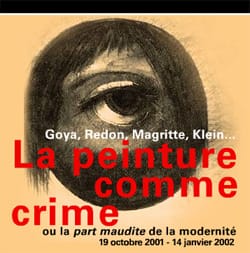
WORST SHOW
La peinture comme crime ou la ‘part maudite’ de la modernité – Painting as crime or the ‘accursed share’ of modernity at the Louvre in the fall of 2001. While it included a large group of marvelous Redon prints and some good Pollocks, they were overwhelmed by the thesis, which was to create a lineage of “transgressiveness and darkness” for a group of Austrian performance artists of the 1970s – I think – whose name escapes me. The videos of their performances were records of unbridled butchery that created rivers of gore, Peckinpaw-style – only the gore was apparently paint Add even more pretentious labels than usual, installing the Pollocks in a black box, with the paintings lit with barn-door spots that made them look like back-lit plastic versions of themselves, and a closing film clip of one of the concentration camps, supposedly justified by the question of whether it is possible to make art after the Holocaust, and you get the idea: pompous, over-determined, contemptuous to the included works of art, and often just plain offensive. In other words, a real winner. It’s also the only exhibition I’ve ever seen at a major museum that was preceded by a parental warning sign (apart from the erotica in the Met’s Art and Love in Renaissance Italy) At the Louvre, it was because of the violence, fictive and real.
Johanna Fassl, assistant professor of Art History and Department Chair at Franklin College Switzerland, and director of Casa Muraro: Columbia University Study Center in Venice, Switzerland/Venice
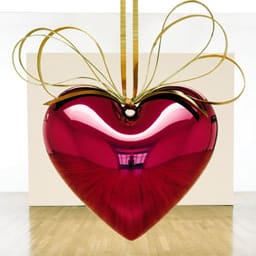
ART WORK
BEST
Damian Hirst’s “Physical Impossibility of Death in the Mind of Someone Living,” even though it was created in 1992, because the controversy around it is infinite, it is a “plight to the public” even if Leo Steinberg will kill me if I cite him here.
WORST
Jeff Koons’ Hanging Heart series – no controversy at all, just banal in five versions
ARTIST
BEST
Bill Viola! tradition, imagination, technology, and innovation together make my heart beat – always
WORST
Jeff Koons – because banal is only banal!
EVENT
BEST
Matthew Barney’s “Cremaster – 3” exhibition at the New York Guggenheim in 2003! It showed that the human imagination truly has no limits
WORST
Hirst’s September 2008 Sotheby’s auction – record prices while the world is collapsing.
CULTURAL PHENOMENON
BEST
Facebook/Twitter! the modern way to initiate a revolution.
WORST
Buy art for investment purposes without ever having seen it – it’s a killer for all imagination.
OBJECT
BEST
The iPhone! It redefined the most ancient form of the tableau – the icon – made it touchable and so revolutionized visual culture altogether.
WORST
The SUV – pompous, arrogant, overstated and polluting.
Ruba Katrib, associate curator at the Museum of Contemporary Art, North Miami, and adjunct professor at the New World School of the Arts, Miami

BEST SHOW
Jean Luc Godard’s exhibition at the Centre Pompidou in 2006. Godard is undoubtedly a genius in film and to top off his talents, he managed to put the majority of the contemporary art world to shame when he fired his curator and continued on to create an inventive and compelling exhibition that has yet to be matched in my mind.
WORST SHOW
There are so many bad things to choose from, but in fairly recent memory, “Younger than Jesus” was the most depressing experience I’ve had in viewing an exhibition that I can recall. Many of the artists that were included are terrific, but when placed in this situation the life was sucked dry. This one keeps bothering me, I can’t pinpoint exactly what caused it, but I had a sinking feeling in my stomach when I left.
Gary Panter, artist and illustrator, New York

The BEST and WORST cultural phenomenon of the last ten years is the gradual evolution of all product, transport and architecture towards the look of complicated tennis shoe design.
William Powhida, artist, New York
BEST
Let me preface this that I think I have to admit to myself that maybe I don’t even like art. Ok, that’s not true, but I’m terrible at applause.
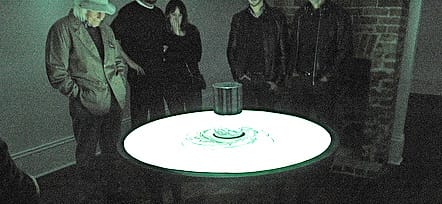
- Bjorn Melhus – little known outside of Germany, this video artist mounted two amazing shows at Roebling Hall that were darkly hilarious, subversive mash-ups of everything from day time talk shows to John Carpenter films. Then, Melhus presented “Weeping” at Roebling Hall’s short lived Soho gallery, Satellite. The split-screen projection featured the artist in corporate attire mouthing the edited, secularized language of an evangelical minister. His character’s predatory resemblance to Christian Bale’s Patrick Bateman from American Psycho contrasted with Rothkoesque color fields and bizarrely moving sermon on “something out there.”
- Tim Hawkinson’s uber organ – I’ve never walked through the belly of a whale singing in the ocean, but encountering Hawkinson’s transparent ‘organs’ at Mass MoCA was about as close as I’ll ever get. You’d think you’d want to avoid that, but the massive installation was overwhelming, awesome, and weird in a way that art seldom ever achieves.
- William Kentridge – How can you avoid the South African who confronts his countries deep shame head on? His animations were mesmerizing, haunting, tragic, and beautiful. That and he writes and directs plays and operas as broadening the possibilities for art.
- Duke Riley’s Naval Battle – Riley’s recreation of the Roman naumachia did something unexpected, he shattered the 4th wall between the performance and the audience to create one of the most truly participatory works of social sculpture of the decade. The event from start to finish brought people together and unified them against everything wrong with the world, represented by battling ships crewed by drunken museum staff. Perhaps it was the copious amount of booze, or the sight of Jade Townsend’s massive ‘flying pig ship’ floating out into the anarchy of battle, it was hard to even call this art. It was something else. My friend Jen Dalton said “It was the coolest thing I’ve ever experienced in my adult life.” Believe her.
- “89 Seconds at Alcazar” – While Eve Sussman may never re-create the momentary magic and surreal dislocation of her 2004 Whitney video, it was one of the most memorable, single art works of the aughts. If artists only have one truly great idea, this was the one to have. It seemed to crystallize all of her ideas about feedback and she used video in a way that transported the viewer through space and time.
- The 2001 Venice Biennale: The Plateau of Humanity – If I believed in the concept of heaven, I’d want it to look and feel like this. Walking through the Gardini pavilions, I experienced brilliant works by German artist Gregor Schnieder who won the Golden Lion for his fractured, inward turning ‘house’ that turned a psychological space into architecture, Janet Cardiff and George Bures Miller’s voyeuristic theatre, and Robert Gober’s austere, jig-saw portrait of American dysfunction. These three installations made the rest of the decade seem weaker somehow in retrospect.
WORST
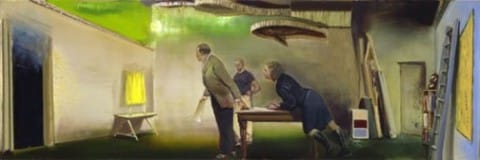
- Neo bad bad painting – I remember going to LFL Gallery and seeing a giant painting of some awkward looking, abstract figures that reminded me of slightly cheerier German neo-expressionism sometime in 2002-3. I thought, haven’t we seen this a million times already? Apparently not. Soon, the Liepszig school arrived at Mass MoCA lead by Neo Rauch mirroring the rise of Dana Schutz, Jules de Balincourt, Peter Doig, and a host of other painters raiding the history books and selling like mad.
- Zach Feuer – For enabling the return of bad bad painting.
- Bush’s Tax Cuts – Fueled both the art boom and the mortgage industry. Stellar results.
- Jeff Koon’s Non-Paintings – Hanging in BCAM, Jeff Koon’s photoshop rendered, studio assistant executed ‘paintings’ are clearly aimed at the history books. Koons probably realized that history favors painters, and had digital photoshop collages fabricated to look like paintings by some talented MFA grads. The results are an insult to painting and sadly people actually call them paintings. They should be called manually executed digital prints.
- Bigfoot – symbolizes what happened in the art world after Hal Foster wrote “The Return of the Real’ as the youthful art world overshot the real into pure, indulgent fantasy lands made of glitter, glue, neon, cardboard, paper, and tiny cartoon characters.
- Greater NY 2005 – exemplified the complete takeover of PS1 by the art market. In 2005, I went through the show with a small notebook looking not at titles, but who was representing the artists. In 2001, there were many artists without representation. It created opportunities for artists. In 2005, almost everyone was already with a commercial gallery, and if they weren’t before the show, I saw a lot of handwritten labels beneath works explaining who they had just been picked up by. In the end the show looked a lot like the art fairs.
- The Great Williamsburg Hype – When it was rumored Jeffery Deitch and other blue chip dealers were going to open spaces in Williamsburg, there was a frenzy of buzz around the burg in 2004. The Williamsburg Gallery Association had recently come into existence and made a desperate attempt to draw collectors over the bridge during Armory with a late night openings and a limo shuttle running from the West Side over the Williamsburg bridge. Sadly, shortly thereafter, Deitch merely opened a practice space for the dreaded FischerSpooner and galleries started the exodus to Chelsea. Bellwether was one of the first, and one of the first to close when the market tanked. RIP Roebling Hall. Hell, Schroeder Romero is on sabbatical until they re-open with Shredder this spring. The hype never amounted to anything and the exodus left a gaping hole in the heart of the Williamsburg art crawl. Props to the galleries that passed on the commercial wave and art still open like Front Room and Pierogi.
- Eli Broad Buying LACMA – this is an oversimplification, but he has his name on a building at LACMA, and way too much influence. The overt branding paved the way for the New Museum to not just bend ethics, but just to ignore them entirely. Bravo Eli, your name will be long remembered, just maybe not the way you imagine, your lordship.
- Down by Law – In 2006, Dan Colen’s vapid sculptures of gum stuck to rocks and Dash Snow’s haphazard collages helped fill the Whitney’s space, there was the Wrong Gallery curated “Down by Law” group show nodding sleepily at political art. Here’s what I said in 2006 and pretty much sums up the extent of political or even critical art in the commercial galleries for the aughts “It’s not that Wiley or DeBalincourt don’t have a political agenda, It’s just clear that their work, like much contemporary art, has no teeth beneath the attractive, accessible imagery.”
Barry Hoggard & James Wagner, publishers, bloggers, collectors & men about town, New York
BEST CULTURAL PHENOMENON

Art Blogs. The rise of art blogs as a compelling alternative to the dwindling coverage of all cultural forms by the mainstream media, and their revitalizing of a critique, still building and surprisingly broad and serious, of institutional practices everywhere in the art world.
WORST CULTURAL PHENOMENON
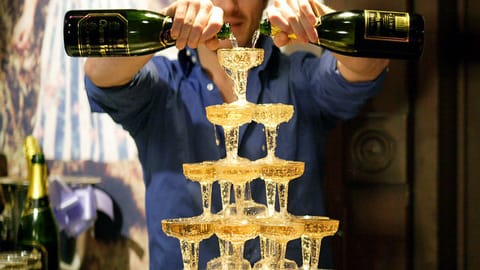
Concentrated Wealth. An art world driven by a market inappropriately dominated by the super wealthy.
An additional note: These particular positive and negative developments seem to mirror what is going on beyond the art world: The decade’s best and the worst social and political developments might be described respectively as the broadening and increasing openness of commentary and critique, and the growing and largely unchallenged command of the wealthy and powerful over the lives of ordinary people.
Lyra Kilston, critic, New York
BEST CULTURAL PHENOMENON
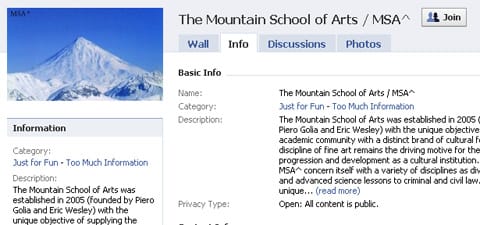
- DIY Schools. Projects like unitednationsplaza, Sundown Schoolhouse, Mountain School of the Arts, Night School, Bruce High Quality Foundation University, the Public School for Architecture, Red 76’s Laundry Lecture Series, and many more gather curious minds together to read, debate, and challenge each other. Sure, they can err on the side of cliquish monoculture, but at their best they can build community and collaboration, empower amateurs, tune you in and turn you on. Plus, there’s no student loan payments for the next 25 years.
WORST CULTURAL PHENOMENA
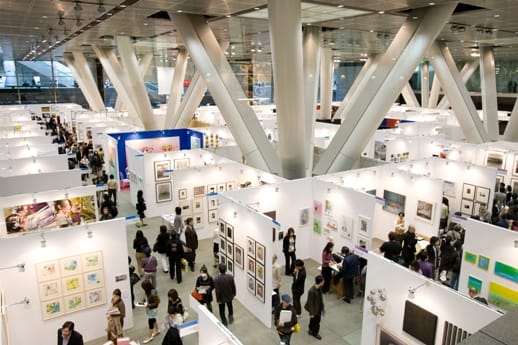
- Art Fairs: These anxiety-filled rat mazes are good for dealers, good for collectors, good for corporate sponsors, good for hotels, good for plastic wine cup manufacturers, good for Ritalin, and good for a few artists who get noticed in the blur. But they’re usually really, really bad for art.
- The Starchitect Solution: Attendance not so great at your local museum? Raise a million dollars for a Liebeskind, Adjaye, or Gehry to drop by and gussy things up. Ka-Pow! Unfortunately, none of these funds go to the curatorial or collection departments (far too unglamorous), so the shows are still kind of dull.
Will Heath, cultural entrepreneur, talent agent, goat shearer, Austin, TX
OMG! I was a sophomore in art school 10 years ago, and the reach of my art world awareness didn’t spill much further than Ann Hamilton and Sarah Sze at the Venice Biennale in 1999. Scanning over my earliest encounters with contemporary art, and subsequently staking my subjectivity upon this decade in review, has been anxiety inducing. When memory failed me I went back to the source, my source at the budding age of 21, for everything art that mattered to me — Art in America, issues July-Dec 1999. I fingered 6 months in an hour to fill in the blanks:
BEST ARTWORK
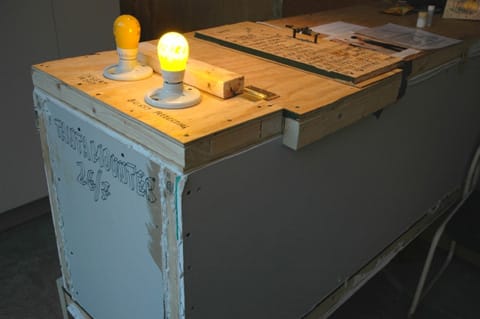
Viennese art collective Gelitin Tantamounter 24/7 a giant “copy-duplicator-transformation machine” for seven days and nights at Leo Koenig Gallery during Performa 05.
WORST ARTWORK
Kristin Jones and Andres Ginzel’s annoyingly cryptic clock, “Metronome,” which was installed February 1999 but really is of this era. One of the most expensive public art fixtures in all of New York City, it hangs heavy above empty storefronts marking the passage of noon and midnight with an eruption of steam that almost mocks the city.
BEST ARTIST
Canadian design enigma Tobias Wong
WORST (or most over exposed) ARTISTS
These three artists have nearly ruined my love affair with dime store finds, drag queens, and found wood: Rachael Harrison, Kalup Linzy, and Deborah Butterfield.
BEST CULTURAL PHENOMENON
The Giuliani menace reached a boiling point when city threatening to withhold the Brooklyn Museum’s municipal funding, remove the board of trustees, and evict the museum if the YBA exhibition Sensation wasn’t canceled. Giuliani’s hard-line attacks against us returned some urgency to the production of art and accelerated our foray into the private sector for funding and support.
WORST CULTURAL PHENOMENON
e-flux and the exponential proliferation of critical theory couched in the format of press release.




